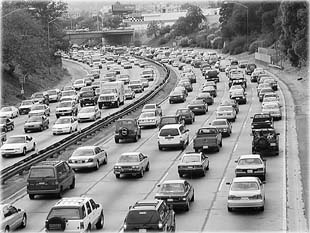
It is well known world over that people who travel more are exposed to increased levels of pollution and they tend to inhale lot more harmful gases than others. The fact that this inhaling of pollution is more dangerous than several other slow poisons was recently discovered by doctors in Los Angeles.
A recent study conducted by the Keck School of Medicine, Los Angeles has found that people who commute by road inhale more pollution while driving than during the entire day. The research was conducted in Los Angeles, where an average driver spends 1.5 hours behind the wheel. This 90 minute period is responsible for the person’s intake of 33 to 45 percent of his total exposure to diesel fumes and ultrafine particles (UFP), said the study report. The study further stated that diesel-fueled trucks are the biggest pollutants and release largest concentrations of these harmful gases, causing the maximum harm to those who commute on freeways.
Speaking to the media after releasing the report one of the researchers, Scott Fruin, assistant professor of environmental health at the Keck School of Medicine of University of Southern California said,
If your habits are healthy and don’t smoke, driving to work is probably the most unhealthy part of your day. Urban dwellers with long commutes are probably getting most of their ultrafine particle exposure while driving.
According to Fruin ultrafine particles are the most dangerous, because, they can penetrate cell walls and disperse throughout the body. High concentration of particulate matter aggravates and sometimes causes cardiovascular disease, but the ultra-fine fraction on roadways appears to be more toxic than larger sized counterparts.
Similar research studies in the past have found that children on school buses inhale lot more pollutant gases than commuters. A study in London discovered that people commuting in public transport such as taxis, buses, and cars inhale substantially more pollution than cyclists and pedestrians.
In the Los Angeles study, which was supported by the California Air Resources Board, researchers measured exposure by outfitting an electric vehicle with air pollution instruments and a video camera to record surrounding traffic and driving conditions on freeways and arterial roads throughout the region. Measurements of pollution levels were computed during a three-month period from February to April 2003. During the study four days were selected for a second-by-second video and statistical analysis.
Speaking about the significance of the findings, Furin detailed that the objective of the research was to find out the effect of driving conditions on commuters. Furin said,
This study was the first to look at the effect of driving and traffic conditions at this level of detail. It was done basically to identify and bring out the specific factors leading to the highest pollutant exposures for drivers. The extent that a specific type of vehicle – diesel trucks – dominated the highest concentration conditions on freeways was unexpected.
He added that driving with windows closed and using recirculating air settings can reduce pollution exposures to a certain extent. But, it doesn’t have any effect on gaseous pollutants, their levels will continue to be the same.
The only way to inhale less pollution is to shorten the commute and spend less time in the car.


